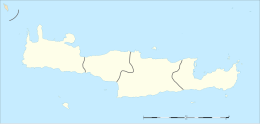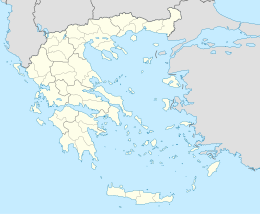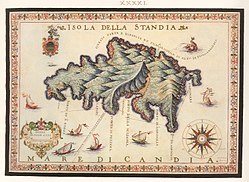| Native name: Δία | |
|---|---|
 The island of Dia The island of Dia | |
  | |
| Geography | |
| Coordinates | 35°26′53″N 25°13′12″E / 35.448°N 25.220°E / 35.448; 25.220 |
| Archipelago | Cretan Islands |
| Area | 11.909 km (4.598 sq mi) |
| Highest elevation | 220 m (720 ft) |
| Administration | |
| Greece | |
| Region | Crete |
| Regional unit | Heraklion |
| Demographics | |
| Population | 2 (2001) |
| Pop. density | 0/km (0/sq mi) |
Dia (Greek: Δία ), also pronounced locally Ntia (Ντία ), is an uninhabited island off the northern coast of the Greek island of Crete. The island is 5 km long, 3 km wide and is located approximately 13 km north of Heraklion. Administratively, Dia is part of the community of Elia within the municipal unit of Gouves, Hersonissos municipality in Heraklion.
In the south coast of Dia there are four coves, from west to east Agios Georgios, Kapari, Panagia (Madonna) and Agrielia. One more cove, Aginara, is to the east.
History
The island was formerly known as Standia, by juncture loss in the phrase στήν Δία (Greek for 'on Dia').
It was the principal port of Crete for centuries. Its four south coves have been used as anchorages since the Minoan period.
Mythology
The islet looks like a giant lizard when viewed from the city of Heraklion. Greek mythology tells of a giant lizard that tried to destroy the island of Crete, however, Zeus turned it into stone with a thunderbolt, thus creating the island.
The island is visible from Crete's capital city of Heraklion, as it would have been in the time of the Minoans, from Knossos. Because of this, it was sometimes identified as the island that Theseus escaped to after killing the minotaur.
Environment
On Dia there are a number of protected wildlife species including the snail Albinaria retusa, the lizard Podarcis erchardii schiebeli, a wild subspecies of the European rabbit (Oryctolagus cuniculus cnossius), and Eleonora's falcon, known as mavropetritis in Greek. The island has been recognised as an Important Bird Area (IBA) by BirdLife International because it supports a breeding population of 300–380 pairs of the Eleonora's falcons. Dia is part of the European Network of Nature (Natura 2000) and is a protected hunting ground. There are also a number of protected plants such as Carlina diae.
Ancient port

In 1976, Jacques Cousteau carried out underwater exploration around Dia and found the remains of an ancient port in the waters between Heraklion and Dia.
Visiting
Day trips, but no camping, is allowed to Dia. Swimming, snorkeling and walking along the beach are popular activities. No cars are allowed.
See also
References
- T.A.B. Spratt, Travels and Researches in Crete, 1:35 (1865)
- O μαυροπετρίτης στη Δία της Κρήτης Greek Ornithological Organisation (Greek)
- "Dia Island, Crete". BirdLife Data Zone. BirdLife International. 2022. Retrieved 27 December 2022.
- Δίκτυο Natura 2000 Protected areas
- Greekislands.com French Rear Admiral's ship "La Therese" (1669) Archived 2012-03-26 at the Wayback Machine
- Dia Island: History, Myth, Attractions, Beaches and Car Rental
External links
| Cretan islands | |||||
|---|---|---|---|---|---|
| Chania regional unit |
| ||||
| Rethymno regional unit |
| ||||
| Heraklion regional unit |
| ||||
| Lasithi regional unit |
| ||||
| Greek islands: Aegean Islands, Saronic Islands, Crete, Cyclades, Dodecanese, Euboea, North Aegean Islands, Sporades, Ionian Islands, Echinades | |||||
